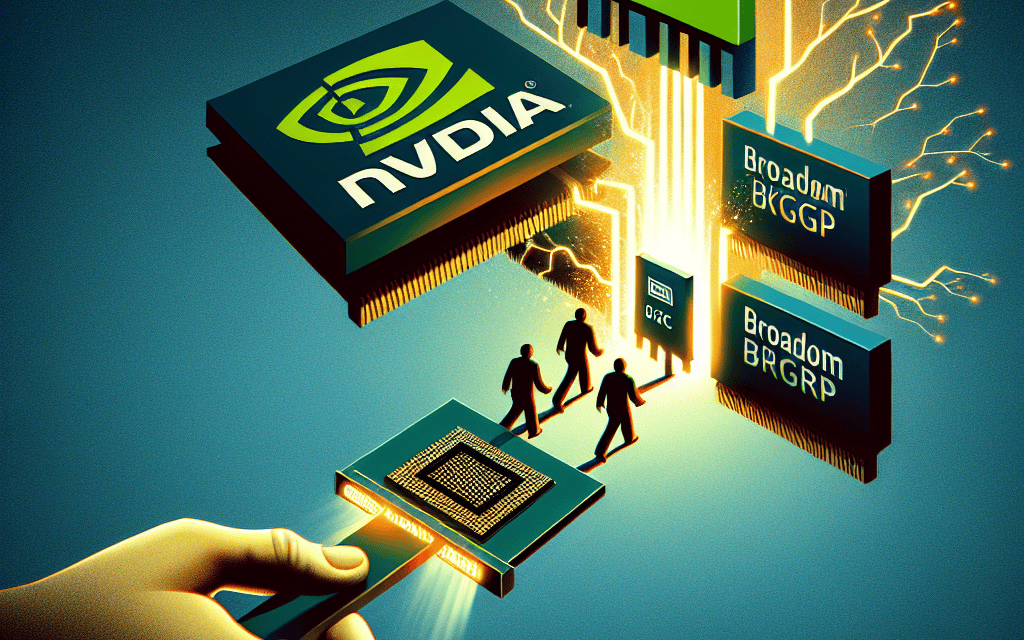“Tech Titans Surge: Nvidia and Broadcom Eye Breakouts Amid Fresh IPO Waves”
Introduction
Nvidia and Broadcom, two titans in the semiconductor industry, are poised for potential breakout performances as they navigate a dynamic market landscape marked by the introduction of two new IPOs. Nvidia, renowned for its cutting-edge graphics processing units and AI innovations, continues to expand its influence across various tech sectors, including gaming, data centers, and autonomous vehicles. Meanwhile, Broadcom, a leader in designing and developing a wide range of semiconductor and infrastructure software solutions, remains a critical player in the global technology supply chain. As these established companies target new growth opportunities, the arrival of fresh IPOs injects additional excitement and competition into the market, promising to reshape industry dynamics and investor strategies.
Nvidia’s Strategic Moves Amidst New IPO Entrants
Nvidia and Broadcom, two giants in the semiconductor industry, are strategically positioning themselves for potential market breakouts as they navigate the evolving landscape shaped by the introduction of two new IPOs. The semiconductor sector, known for its rapid technological advancements and intense competition, is witnessing a dynamic shift with these new entrants. As these companies prepare to go public, Nvidia and Broadcom are not merely passive observers; instead, they are actively recalibrating their strategies to maintain their competitive edge.
Nvidia, renowned for its cutting-edge graphics processing units (GPUs) and artificial intelligence (AI) capabilities, is leveraging its technological prowess to solidify its market position. The company has been investing heavily in research and development to enhance its product offerings, particularly in AI and machine learning, which are increasingly becoming integral to various industries. By focusing on innovation, Nvidia aims to differentiate itself from emerging competitors and capture a larger share of the growing demand for AI-driven solutions. Furthermore, Nvidia’s strategic partnerships and acquisitions are pivotal in expanding its ecosystem, thereby creating a more comprehensive suite of products and services that cater to a broader range of applications.
Simultaneously, Broadcom, a leader in semiconductor and infrastructure software solutions, is also making calculated moves to ensure its continued dominance. The company is focusing on diversifying its product portfolio to include more software-driven solutions, recognizing the increasing convergence of hardware and software in the tech industry. By doing so, Broadcom is not only enhancing its value proposition but also mitigating risks associated with market volatility in the hardware sector. Additionally, Broadcom’s emphasis on strategic collaborations and long-term contracts with key industry players is instrumental in securing a stable revenue stream, thereby reinforcing its market position amidst the influx of new competitors.
The entry of two new IPOs into the semiconductor market adds an intriguing dimension to the competitive landscape. These companies, armed with innovative technologies and fresh perspectives, are poised to challenge established players like Nvidia and Broadcom. However, the incumbents’ extensive experience and robust infrastructure provide them with a significant advantage. Nvidia and Broadcom’s ability to adapt to changing market dynamics and anticipate future trends will be crucial in maintaining their leadership positions.
Moreover, the broader implications of these developments extend beyond the semiconductor industry. The success of these IPOs could potentially attract more investment into the sector, spurring further innovation and competition. This, in turn, could lead to accelerated technological advancements, benefiting consumers and businesses alike. As the industry evolves, Nvidia and Broadcom’s strategic initiatives will likely serve as a benchmark for other companies seeking to navigate the complexities of a rapidly changing market.
In conclusion, Nvidia and Broadcom are proactively addressing the challenges and opportunities presented by the arrival of new IPOs in the semiconductor industry. Through strategic investments, innovation, and collaboration, they are positioning themselves for potential breakouts while reinforcing their market leadership. As the industry continues to evolve, their ability to adapt and innovate will be key determinants of their success. The unfolding scenario promises to be a fascinating one, with significant implications for the future of technology and the global economy.
Broadcom’s Market Positioning in a Competitive Landscape
In the ever-evolving landscape of technology, Broadcom has consistently positioned itself as a formidable player, navigating the competitive waters with strategic acumen. As the semiconductor industry experiences rapid advancements, Broadcom’s market positioning becomes increasingly significant, especially as it seeks to maintain its competitive edge amidst emerging challenges and opportunities. The company’s robust portfolio, which spans across various sectors including data centers, networking, and broadband, underscores its commitment to innovation and adaptability. This diverse range of offerings not only fortifies Broadcom’s market presence but also enables it to cater to a wide array of customer needs, thereby enhancing its resilience against market fluctuations.
Moreover, Broadcom’s strategic acquisitions have played a pivotal role in bolstering its market position. By integrating complementary technologies and expanding its capabilities, Broadcom has managed to create synergies that drive growth and efficiency. These acquisitions have not only expanded its technological prowess but have also allowed the company to tap into new markets, thereby broadening its revenue streams. In a competitive landscape where technological advancements are relentless, such strategic maneuvers are crucial for sustaining long-term growth and maintaining a competitive advantage.
In parallel, Nvidia, another titan in the semiconductor industry, is also targeting breakout opportunities, further intensifying the competitive dynamics. Nvidia’s focus on artificial intelligence and high-performance computing has positioned it as a leader in these burgeoning fields. As both companies vie for dominance, their strategies and market positioning will undoubtedly influence the broader industry landscape. The interplay between these two giants highlights the importance of innovation and strategic foresight in navigating the complexities of the semiconductor market.
Amidst this backdrop, the entry of two new IPOs into the scene adds another layer of complexity to the competitive landscape. These new entrants bring fresh perspectives and innovative solutions, challenging established players like Broadcom and Nvidia to continuously evolve and adapt. The introduction of new technologies and business models by these IPOs could potentially disrupt existing market dynamics, prompting established companies to reassess their strategies and explore new avenues for growth.
In this context, Broadcom’s ability to leverage its strengths and capitalize on emerging opportunities will be critical. The company’s focus on research and development, coupled with its strategic partnerships, positions it well to navigate the challenges posed by new entrants and evolving market demands. By fostering a culture of innovation and agility, Broadcom can continue to deliver value to its customers and stakeholders, thereby reinforcing its market position.
Furthermore, as the semiconductor industry becomes increasingly interconnected with other sectors such as automotive, healthcare, and telecommunications, Broadcom’s ability to adapt and integrate its solutions across these domains will be essential. The convergence of technologies presents both challenges and opportunities, and Broadcom’s strategic positioning will play a crucial role in determining its success in this dynamic environment.
In conclusion, Broadcom’s market positioning in a competitive landscape is characterized by its strategic acquisitions, diverse portfolio, and focus on innovation. As the company navigates the challenges posed by new IPOs and the evolving semiconductor industry, its ability to adapt and capitalize on emerging opportunities will be key to sustaining its competitive edge. The interplay between established players like Broadcom and Nvidia, along with the entry of new market participants, underscores the dynamic nature of the industry and the importance of strategic foresight in achieving long-term success.
Analyzing the Impact of New IPOs on Nvidia and Broadcom
The technology sector is perpetually evolving, with established giants like Nvidia and Broadcom continually adapting to maintain their competitive edge. As two new IPOs enter the scene, the dynamics within the industry are poised for potential shifts, prompting an analysis of how these developments might impact Nvidia and Broadcom. The introduction of new players in the market often brings fresh innovation and competition, which can influence the strategies and performance of existing companies. In this context, understanding the potential implications for Nvidia and Broadcom becomes crucial.
Nvidia, renowned for its cutting-edge graphics processing units (GPUs) and artificial intelligence (AI) capabilities, has consistently demonstrated its ability to innovate and capture significant market share. However, the arrival of new IPOs could introduce novel technologies or business models that challenge Nvidia’s dominance. For instance, if these new entrants focus on AI or machine learning, Nvidia might need to accelerate its research and development efforts to maintain its leadership position. Moreover, the increased competition could lead to pricing pressures, compelling Nvidia to explore cost-effective solutions without compromising on quality.
Similarly, Broadcom, a key player in the semiconductor industry, faces its own set of challenges and opportunities with the emergence of new IPOs. Broadcom’s extensive portfolio, which includes products ranging from wireless communication chips to enterprise storage solutions, positions it well to withstand competitive pressures. However, the company must remain vigilant and responsive to any technological advancements introduced by the newcomers. If the IPOs bring forth innovations in semiconductor design or manufacturing processes, Broadcom may need to reassess its strategies to ensure it remains at the forefront of the industry.
Transitioning to the broader market implications, the entry of new IPOs can also influence investor sentiment and capital allocation. Investors often seek opportunities in emerging companies with high growth potential, which could divert attention and resources away from established firms like Nvidia and Broadcom. Consequently, these tech giants might experience fluctuations in their stock prices as market participants reassess their portfolios. However, this scenario also presents an opportunity for Nvidia and Broadcom to demonstrate their resilience and adaptability, potentially reinforcing investor confidence in their long-term prospects.
Furthermore, the introduction of new IPOs can stimulate collaboration and partnerships within the industry. Nvidia and Broadcom might explore strategic alliances with these emerging companies to leverage complementary technologies or expand their market reach. Such collaborations could foster innovation and drive growth, benefiting all parties involved. By embracing a cooperative approach, Nvidia and Broadcom can mitigate competitive threats while capitalizing on new opportunities.
In conclusion, the arrival of new IPOs in the technology sector presents both challenges and opportunities for established players like Nvidia and Broadcom. While increased competition may necessitate strategic adjustments, it also encourages innovation and collaboration. By remaining agile and responsive to market changes, Nvidia and Broadcom can continue to thrive in an ever-evolving industry landscape. As these tech giants navigate the complexities of a dynamic market, their ability to adapt and innovate will be key to sustaining their leadership positions and delivering value to stakeholders.
Technological Innovations Driving Nvidia’s Growth

Nvidia Corporation, a leader in the semiconductor industry, has consistently demonstrated its prowess in technological innovation, driving significant growth and capturing the attention of investors worldwide. The company’s focus on developing cutting-edge graphics processing units (GPUs) and artificial intelligence (AI) technologies has positioned it at the forefront of the tech industry. As Nvidia continues to push the boundaries of what is possible, it is essential to understand the factors contributing to its success and how these innovations are shaping the future of technology.
One of the primary drivers of Nvidia’s growth is its relentless pursuit of advancements in AI and machine learning. The company’s GPUs are not only essential for gaming but have also become critical components in data centers, where they are used to accelerate AI workloads. This dual application has allowed Nvidia to tap into multiple markets, thereby diversifying its revenue streams. Moreover, the increasing demand for AI-driven solutions across various industries, from healthcare to automotive, has further fueled Nvidia’s expansion. As AI continues to evolve, Nvidia’s role in providing the necessary hardware and software solutions is expected to grow, solidifying its position as a key player in the tech ecosystem.
In addition to AI, Nvidia’s innovations in the field of autonomous vehicles have garnered significant attention. The company’s DRIVE platform, which provides end-to-end solutions for autonomous driving, is a testament to its commitment to revolutionizing transportation. By leveraging its expertise in AI and deep learning, Nvidia is enabling automakers to develop safer and more efficient self-driving cars. This initiative not only highlights Nvidia’s technological capabilities but also underscores its strategic vision of transforming industries through innovation.
Furthermore, Nvidia’s strategic partnerships and acquisitions have played a crucial role in its growth trajectory. By collaborating with other tech giants and acquiring companies with complementary technologies, Nvidia has been able to enhance its product offerings and expand its market reach. These strategic moves have not only bolstered Nvidia’s competitive edge but have also positioned it to capitalize on emerging trends in the tech industry.
As Nvidia continues to innovate, it is also important to consider the broader market dynamics that are influencing its growth. The semiconductor industry is experiencing a period of rapid transformation, driven by the increasing demand for advanced technologies such as 5G, the Internet of Things (IoT), and edge computing. Nvidia’s ability to adapt to these changes and develop solutions that address the evolving needs of the market is a testament to its resilience and foresight.
In parallel, Broadcom, another major player in the semiconductor industry, is also targeting breakouts with its focus on connectivity solutions. As both companies navigate the complexities of the tech landscape, their efforts are further complemented by the entrance of two new IPOs, which are set to bring fresh perspectives and innovations to the industry. These developments highlight the dynamic nature of the tech sector and the continuous drive for innovation that propels companies like Nvidia and Broadcom forward.
In conclusion, Nvidia’s growth is a result of its unwavering commitment to technological innovation and strategic foresight. By capitalizing on emerging trends and leveraging its expertise in AI and autonomous vehicles, Nvidia is well-positioned to continue its upward trajectory. As the tech industry evolves, the interplay between established giants like Nvidia and Broadcom and new entrants will undoubtedly shape the future of technology, offering exciting opportunities and challenges for all stakeholders involved.
Broadcom’s Expansion Strategies in Emerging Markets
In the rapidly evolving landscape of technology, companies like Broadcom are constantly seeking new avenues for growth and expansion. As the semiconductor industry continues to experience unprecedented demand, Broadcom has strategically positioned itself to capitalize on emerging markets. This approach not only diversifies its revenue streams but also mitigates risks associated with market saturation in more developed regions. By targeting these burgeoning markets, Broadcom aims to establish a strong foothold that will drive its long-term growth and sustainability.
One of the key strategies Broadcom employs in its expansion into emerging markets is forming strategic partnerships with local companies. These collaborations allow Broadcom to leverage the existing infrastructure and market knowledge of its partners, thereby facilitating a smoother entry into new territories. Moreover, such alliances enable Broadcom to tailor its products and services to meet the specific needs and preferences of local consumers, enhancing its competitive edge. This approach is particularly crucial in regions where cultural nuances and regulatory environments can significantly impact business operations.
In addition to partnerships, Broadcom is heavily investing in research and development to innovate products that cater to the unique demands of emerging markets. By focusing on creating cost-effective and energy-efficient solutions, Broadcom is addressing the challenges faced by these regions, such as limited access to resources and infrastructure. This commitment to innovation not only strengthens Broadcom’s product portfolio but also reinforces its reputation as a leader in the semiconductor industry. Furthermore, by prioritizing sustainability in its product development, Broadcom aligns itself with the global shift towards environmentally conscious business practices, which is increasingly important to consumers and investors alike.
While Broadcom’s expansion into emerging markets presents significant opportunities, it is not without challenges. Navigating the complex regulatory landscapes of these regions requires a deep understanding of local laws and compliance requirements. To address this, Broadcom has invested in building a robust legal and compliance team that works closely with local authorities to ensure adherence to all regulations. This proactive approach minimizes the risk of legal complications and fosters positive relationships with government bodies, which can be instrumental in facilitating business operations.
Moreover, Broadcom’s focus on emerging markets is complemented by its efforts to enhance its supply chain resilience. By diversifying its supplier base and investing in local manufacturing facilities, Broadcom reduces its dependency on a single source and mitigates the risks associated with global supply chain disruptions. This strategic move not only ensures a steady supply of components but also supports local economies by creating job opportunities and fostering economic growth.
As Broadcom continues to expand its presence in emerging markets, it remains committed to maintaining its core values of innovation, sustainability, and customer-centricity. By aligning its business strategies with the evolving needs of these regions, Broadcom is well-positioned to capture a significant share of the market and drive its growth trajectory. In conclusion, Broadcom’s expansion strategies in emerging markets exemplify its forward-thinking approach and dedication to long-term success. As the company navigates the complexities of these regions, it sets a benchmark for other industry players seeking to explore new frontiers in the ever-changing global market.
The Role of AI in Nvidia’s Future Prospects
Nvidia, a leading player in the semiconductor industry, has long been at the forefront of technological innovation, particularly in the realm of graphics processing units (GPUs). As the demand for artificial intelligence (AI) continues to surge, Nvidia’s strategic focus on AI-driven solutions positions it as a pivotal force in shaping the future of technology. The company’s commitment to AI is evident in its robust product offerings and strategic partnerships, which are designed to harness the transformative potential of AI across various sectors.
One of the key factors driving Nvidia’s future prospects is its ability to integrate AI capabilities into its existing product lines. The company’s GPUs, renowned for their high-performance computing power, are increasingly being optimized for AI applications. This optimization is crucial as AI workloads require immense computational resources, and Nvidia’s GPUs are well-suited to meet these demands. By enhancing the AI capabilities of its GPUs, Nvidia is not only catering to the needs of AI researchers and developers but also expanding its market reach into industries such as healthcare, automotive, and finance, where AI is becoming an integral part of operations.
Moreover, Nvidia’s strategic acquisitions and partnerships further underscore its commitment to AI. The acquisition of companies specializing in AI and machine learning technologies has enabled Nvidia to bolster its expertise and expand its portfolio of AI-driven solutions. These acquisitions are complemented by strategic partnerships with leading technology firms and research institutions, which facilitate collaborative efforts in AI research and development. Through these collaborations, Nvidia is able to stay at the cutting edge of AI innovation, ensuring that its products remain relevant and competitive in a rapidly evolving technological landscape.
In addition to its product and partnership strategies, Nvidia’s investment in AI research and development is a testament to its long-term vision. The company allocates significant resources to advancing AI technologies, with a focus on developing new algorithms, improving data processing capabilities, and enhancing the efficiency of AI models. This investment not only strengthens Nvidia’s position as a leader in AI but also contributes to the broader advancement of AI technologies, benefiting the industry as a whole.
As Nvidia continues to leverage AI to drive its growth, it faces competition from other industry players, such as Broadcom, which is also targeting breakouts in the semiconductor market. Broadcom’s focus on diversifying its product offerings and expanding into new markets presents a competitive challenge for Nvidia. However, Nvidia’s strong foothold in AI gives it a distinct advantage, as the demand for AI-driven solutions is expected to grow exponentially in the coming years.
Meanwhile, the entry of two new IPOs into the semiconductor scene adds another layer of complexity to the competitive landscape. These new entrants bring fresh perspectives and innovative technologies, potentially disrupting established market dynamics. For Nvidia, this means staying agile and continuously innovating to maintain its leadership position. By capitalizing on its strengths in AI, Nvidia is well-positioned to navigate these challenges and seize new opportunities.
In conclusion, Nvidia’s strategic focus on AI is a key driver of its future prospects. Through the integration of AI capabilities into its products, strategic acquisitions and partnerships, and substantial investment in AI research and development, Nvidia is poised to remain a dominant force in the semiconductor industry. As the demand for AI continues to grow, Nvidia’s commitment to innovation and excellence will be instrumental in shaping the future of technology.
Broadcom’s Investment in Next-Gen Technologies
In the rapidly evolving landscape of technology, companies like Broadcom are continually seeking to position themselves at the forefront of innovation. As Nvidia and Broadcom target breakouts, the strategic investments made by Broadcom in next-generation technologies are particularly noteworthy. These investments are not only pivotal for the company’s growth but also for maintaining its competitive edge in an industry characterized by relentless advancement and fierce competition.
Broadcom, a global technology leader, has consistently demonstrated its commitment to innovation through substantial investments in research and development. This commitment is evident in its focus on next-generation technologies, which are poised to redefine the technological landscape. By channeling resources into areas such as artificial intelligence, 5G, and the Internet of Things (IoT), Broadcom is positioning itself to capitalize on emerging trends that are expected to drive the next wave of technological transformation.
One of the key areas where Broadcom is making significant strides is in the development of advanced semiconductor solutions. As the demand for faster and more efficient processing capabilities continues to grow, Broadcom’s investment in cutting-edge semiconductor technology is crucial. These advancements are not only essential for enhancing the performance of existing devices but also for enabling the development of new applications that were previously unimaginable. By focusing on semiconductor innovation, Broadcom is ensuring that it remains a vital player in the tech industry, capable of meeting the evolving needs of its customers.
Moreover, Broadcom’s investment strategy is not limited to internal development. The company is also actively pursuing strategic partnerships and acquisitions to bolster its technological capabilities. By collaborating with other industry leaders and acquiring companies with complementary technologies, Broadcom is able to accelerate its innovation efforts and expand its product offerings. This approach not only enhances Broadcom’s competitive position but also allows it to tap into new markets and customer segments.
In addition to its focus on semiconductors, Broadcom is also investing heavily in the development of 5G technology. As the world moves towards widespread 5G adoption, the demand for infrastructure and devices that can support this new standard is increasing. Broadcom’s investment in 5G technology is aimed at capturing a significant share of this burgeoning market. By developing solutions that enable faster and more reliable connectivity, Broadcom is positioning itself as a key enabler of the 5G revolution.
Furthermore, Broadcom’s commitment to next-generation technologies extends to the realm of artificial intelligence. As AI continues to permeate various aspects of business and daily life, the need for advanced AI solutions is becoming increasingly apparent. Broadcom’s investment in AI technology is focused on developing solutions that enhance the capabilities of existing systems while also enabling the creation of new applications. This investment is critical for ensuring that Broadcom remains at the cutting edge of technological innovation.
As Nvidia and Broadcom target breakouts, the strategic investments made by Broadcom in next-generation technologies underscore its commitment to innovation and growth. By focusing on areas such as semiconductors, 5G, and AI, Broadcom is positioning itself to capitalize on emerging trends and maintain its competitive edge in the tech industry. Through a combination of internal development, strategic partnerships, and acquisitions, Broadcom is ensuring that it remains a key player in the rapidly evolving technological landscape. As new IPOs enter the scene, Broadcom’s investment strategy serves as a testament to its forward-thinking approach and its dedication to shaping the future of technology.
Q&A
1. **What is Nvidia’s current market focus?**
Nvidia is focusing on expanding its capabilities in AI, data centers, and gaming technologies.
2. **How is Broadcom positioned in the tech industry?**
Broadcom is a major player in semiconductor and infrastructure software solutions, with a strong presence in networking and storage.
3. **What recent developments have impacted Nvidia’s stock performance?**
Nvidia’s stock performance has been influenced by its advancements in AI technology and strong earnings reports.
4. **What strategic moves has Broadcom made recently?**
Broadcom has been involved in strategic acquisitions to enhance its software and semiconductor offerings.
5. **Which new IPOs are entering the market?**
The new IPOs entering the market include companies from the tech and biotech sectors, though specific names would depend on the current market conditions.
6. **How might these IPOs affect Nvidia and Broadcom?**
New IPOs can increase competition in the tech sector, potentially impacting Nvidia and Broadcom’s market share and innovation strategies.
7. **What are analysts predicting for Nvidia and Broadcom’s future performance?**
Analysts generally predict continued growth for both companies, driven by their strong market positions and ongoing innovation in key technology areas.
Conclusion
Nvidia and Broadcom have been pivotal players in the semiconductor industry, consistently demonstrating strong market performance and innovation. As two new IPOs enter the scene, these established companies are likely to maintain their leadership positions due to their robust product portfolios, strategic partnerships, and significant investments in emerging technologies such as AI and 5G. While the new IPOs may introduce fresh competition and innovation, Nvidia and Broadcom’s established market presence and ongoing advancements position them well to capitalize on growth opportunities and potentially achieve target breakouts. However, they must remain vigilant and adaptive to the evolving market dynamics to sustain their competitive edge.





